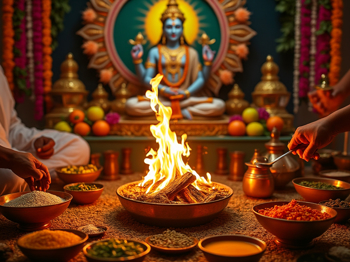



Satyanarayan Katha and Havan is a revered Hindu ritual dedicated to Lord Vishnu, specifically in his manifestation as Satyanarayan, the embodiment of truth and righteousness. This sacred ceremony is typically performed to express gratitude, seek blessings, and fulfill vows. It is considered an auspicious occasion that brings together family and friends in a collective act of devotion and spiritual reflection. The ritual is often conducted on full moon days (Purnima), during special occasions such as weddings, housewarming ceremonies, or after achieving a significant milestone. The ceremony consists of a detailed recitation of the Satyanarayan Katha—a narrative that glorifies the power and blessings of Lord Satyanarayan—accompanied by a Havan, a sacred fire ritual that involves offering oblations to the deities.

The Satyanarayan Katha and Havan hold immense spiritual and cultural significance in Hindu tradition. The Katha narrates the importance of truth and the consequences of adhering to or deviating from the path of righteousness. It emphasizes the virtues of honesty, devotion, and gratitude, illustrating how Lord Satyanarayan blesses those who maintain their faith and truthfulness. The Havan, a key component of the ritual, symbolizes the purification of the mind, body, and environment, creating a sacred space for divine blessings. Together, the Katha and Havan represent a holistic approach to spiritual upliftment and community harmony.
Spiritual Blessings: Invokes the grace and blessings of Lord Satyanarayan, ensuring protection, prosperity, and overall well-being for the devotee and their family.
Fulfillment of Desires: It is believed that performing this ritual with sincerity can help in the fulfillment of one’s wishes and desires, including success in personal and professional endeavors.
Purification: The Havan purifies the environment and the participants, removing negative energies and fostering a positive, divine atmosphere.
Mental Peace: The chanting, prayers, and offerings help calm the mind, reducing stress and anxiety, and promoting inner peace and contentment.
Strengthening Faith: The ritual reinforces devotion and faith in God, helping devotees stay on the path of righteousness and truth.
Bringing Harmony: Performing the Katha and Havan as a family or community fosters unity, understanding, and collective spiritual growth.
Protection from Negativity: The ritual is believed to protect against evil influences, negative energies, and misfortunes.
Enhanced Prosperity: It is said to attract prosperity and abundance, ensuring material and spiritual wealth for those who participate in the puja with devotion.
Vow Fulfillment: Many devotees perform the Satyanarayan Katha as a vow, and it is believed that the ritual helps in the successful completion of such vows.
The Satyanarayan Katha and Havan are traditional Hindu rituals performed to worship Lord Vishnu in his form as Satyanarayan, the embodiment of truth. These rituals are usually performed on auspicious occasions or after fulfilling a vow. Here's a step-by-step guide to performing the Satyanarayan Katha and Havan:
Prayers and Blessings:
Dhyaan (Meditation):
Prasad Distribution:
Performing the Satyanarayan Katha and Havan with devotion and sincerity is believed to bring immense blessings, peace, and prosperity to the devotees and their families.
Satyanarayana Katha (Story of Lord Satyanarayana)
The Satyanarayana Katha is a revered story in Hindu tradition, commonly recited during the Satyanarayana Puja, a ritual worship of Lord Vishnu in his form as Satyanarayana, the embodiment of truth. This story is believed to bring prosperity, peace, and the fulfillment of desires when heard or recited with devotion.
Once upon a time, in the celestial abode, the great sage Narada, known for his devotion and wisdom, approached Lord Vishnu. He humbly asked, "O Lord, please tell me how your devotees on Earth can attain peace, prosperity, and liberation."
Lord Vishnu, with a compassionate smile, replied, "O Narada, I will tell you about a sacred vow, the Satyanarayana Vrata, which, when observed with devotion, fulfills all desires and brings immense blessings. Anyone who performs this Puja will be blessed with wealth, children, peace, and eternal happiness."
Thus, Lord Vishnu narrated the significance of the Satyanarayana Puja to Narada, who then carried the message to the world of mortals.
In a small village, there lived a poor Brahmin who struggled to make ends meet. Despite his hardships, he was a pious man who worshipped Lord Vishnu daily. One day, as he was wandering in search of alms, he encountered Lord Vishnu disguised as an old man. The old man, seeing the Brahmin's devotion, asked, "Why are you so troubled, my son?"
The Brahmin narrated his woes. The old man then told him about the Satyanarayana Vrata and its benefits. He advised the Brahmin to perform the Puja with sincerity, which would alleviate his sufferings.
The Brahmin returned home and, with whatever little he had, performed the Puja. Soon after, his fortunes changed. He became prosperous, and his life was filled with joy and peace. He continued to perform the Satyanarayana Puja regularly, and his faith in Lord Vishnu grew stronger day by day.
In the same village, there lived a woodcutter who earned his livelihood by selling wood. One day, as he was returning from the forest, he felt tired and sat under a tree to rest. There, he overheard a group of villagers talking about the blessings received after performing the Satyanarayana Puja.
The woodcutter, though uneducated, was a devout believer. He decided to perform the Puja. With his meager earnings, he bought the necessary items and performed the Satyanarayana Puja with utmost devotion.
Soon after, his life began to change. He found a huge treasure hidden in the forest, which made him wealthy overnight. Grateful for the blessings, the woodcutter continued to perform the Puja every full moon day, and his devotion to Lord Satyanarayana never wavered.
There was a wealthy merchant named Sadhu who was highly successful in his trade. However, despite his wealth, he was childless and unhappy. One day, while traveling on business, he stopped by a village where he saw the villagers performing the Satyanarayana Puja. Curious, he inquired about it and was told of its divine benefits.
Desperate for a child, Sadhu vowed to perform the Puja if he was blessed with a son. True to his word, Lord Satyanarayana blessed him, and soon his wife gave birth to a beautiful boy.
However, as years passed, Sadhu became so engrossed in his business and the pleasures of life that he forgot his vow. One day, while on a sea voyage with his son, a great storm arose, threatening to sink the ship. In a panic, Sadhu prayed to Lord Satyanarayana, realizing his mistake.
The Lord, being merciful, saved them from the storm. Upon returning home, Sadhu immediately performed the Satyanarayana Puja with his family and sought forgiveness for his forgetfulness. From that day onward, Sadhu never failed to perform the Puja and lived a life filled with divine blessings.
A pious king named Tungadhwaja ruled a prosperous kingdom. He was a just ruler and devoted to Lord Vishnu. However, one day, while he was out hunting, he came across a group of villagers performing the Satyanarayana Puja. The king, in his arrogance, refused to acknowledge the Puja and did not bow before the deity.
As a result, the king's fortunes began to decline. His kingdom was struck by famine, and he lost his wealth and power. Realizing his mistake, the king repented and sought refuge in Lord Satyanarayana. He performed the Puja with sincerity and devotion, seeking forgiveness.
The compassionate Lord Vishnu forgave the king, and soon, his kingdom was restored to its former glory. From that day on, King Tungadhwaja made the Satyanarayana Puja a regular part of his life and encouraged his subjects to do the same.
The Satyanarayana Katha teaches us the importance of faith, devotion, and humility. It reminds us that the Lord is always there to protect and bless those who sincerely seek His refuge. The Puja, when performed with a pure heart and devotion, brings immense joy, prosperity, and fulfillment of all desires.
Thus, the Satyanarayana Katha is not just a story but a spiritual guide for leading a life of righteousness and devotion. May Lord Satyanarayana bless all who listen to or recite this sacred Katha.